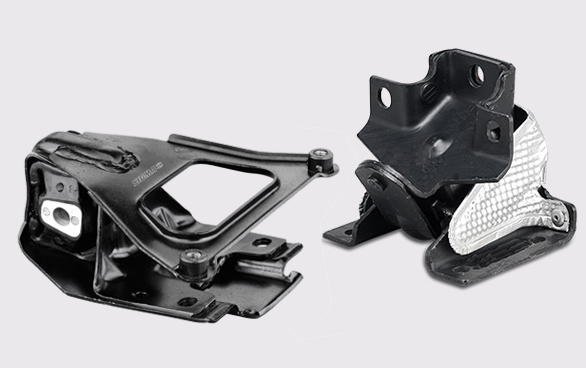
Engine & Transmission Mounts perform their function in silence under the engine for the life of the vehicle. Their critical function goes unnoticed because they are hidden between the sub-frame of the car and the engine. However their failure makes us understand the critical functions and their impact on performance of our vehicles. They not only bear the engine weight but also support the torque generated when the vehicle moves. The combustion noise of the engine combined with its heavy weight pose a challenge when vehicle is running and vibrations are further excited by severe road conditions and maneuvers such as braking and cornering. Severe and extreme weather conditions pose a great threat to the life and performance of an Engine Mount.. Sigma Engine and Transmission Mounts are designed to match OE standards of fit, function, performance and materials (natural rubber, high tensile steel, aluminum die cast and polymers) to deliver to you the desired static and dynamic loads, isolate engine noise and dampen engine vibrations in extreme weather conditions. For the Right product to match your vehicle, make, model, year and engine please click on our E-Catalogue.

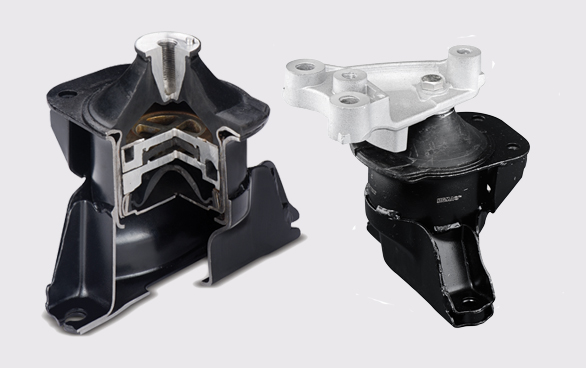
In a Hydro Mount the function of isolation and damping are performed separately .The mount itself is made from a low damping material which performs the isolation function, while the damping function is performed by the hydraulic system integrated in the component. During the compression and expansion of the Hydro Mount (large deformations), the mount functions as a pump which forces the damping fluid in the system through a channel, with Hydrodynamic resistance absorbing the vibration Energy.
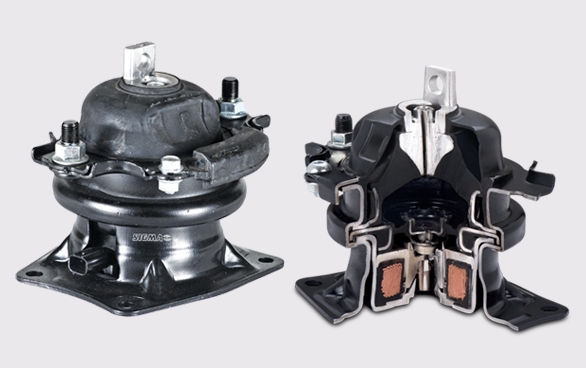
Hydraulic Mounts improve ride comfort through damping, but they tend to harden at frequencies above maximum damping point as mass in the channel develops greater inertia and fluid is pumped into the expansion spring. However direct injection diesel engines with markedly reduced idling speeds tend to shake severely at idle and vibrate with amplitude between 0.1 to 0.3 mm. This shaking effect can be combatted with a long channel sized for absorption rather than damping. To provide both functions, it is necessary to use switchable mounts whose spring rate can be lowered at idle frequencies between 25 and 60 Hz, but function as normal Hydro Mounts while driving.
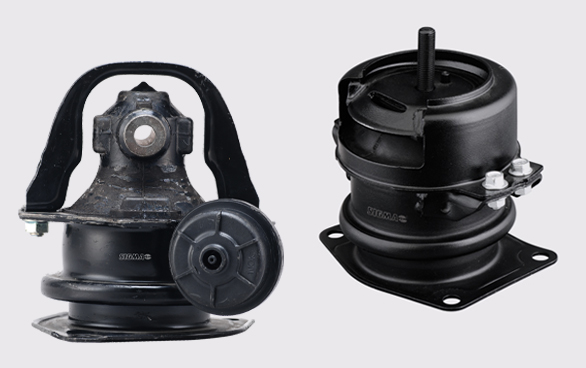
Following the electrically switchable mounts with their heavy, bulky and energy-intensive electromagnets, the NVH engineers took a further step and now offer Hydro Mounts that function as absorbers at idling speeds. In these types of mounts a second channel is opened and closed by an actuator depending on the operating condition.
A vacuum chamber supplied with the vacuum pressure by the brake system via a solenoid valve has proven to be an effective actuator solution. Typically in the case of this standard part the normal position of the chamber is the driving position, in which the central channel is closed by a spring (in driving operation, no vacuum is applied) ensuring the diaphragm is loose resulting in a classical Hydro mount function.
At idling position, when the vacuum is applied to the vacuum chamber the spring is compressed (pulling the spring towards the cover) causing the plate attached to the switching spring to move and release central opening. In this position the mount performs the idling absorption function.
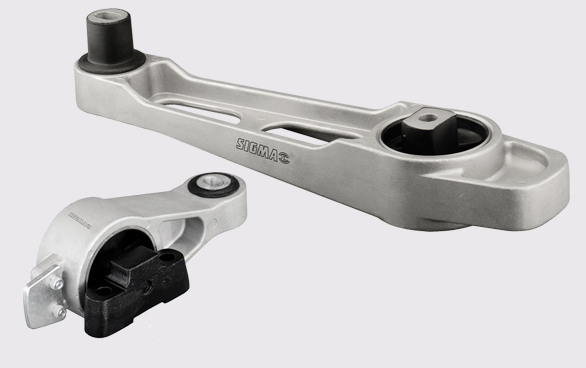
If it is necessary to absorb high forces resulting from torque horizontally with little effect on the other directions, Torque Struts are used. Torque struts consist of two bushings and a rod. The two bushings act as joints and transfer forces only in the direction of the rod. Normally one bushing is very hard and defines the engine frequency of the rod between the bushings while the other is very soft, large and well isolated and defines the properties of the mount. Apart from radial legs the second bushing has buffers that are initially very soft and progressive to minimize jolts caused by throttle changes and movement of engine and transmission unit, which could cause contact with the bodywork. The rods can be of different lengths and families. Most commonly used materials are aluminum rods (typically extruded), Steel rods with combination of steel pipes and different composition of rubber compounds for bushings to adapt to specific vehicle loads.
Engine and Transmission Mounts have several quite different and to some extent conflicting functions:
Elastomeric compounds for Engine and Transmission Mounts:
At SIGMA we take pride in producing our own rubber compounds and ensuring our mounts incorporate the key criteria while developing elastomeric compounds for our engine & transmission mounts:
Metals "Substrates" are the surfaces to which the elastomers are to be bonded. These are mainly steel sheets, aluminum die cast, extrusions, deep drawn parts, tubes, castings. Our product development and design teams decide on the materials to be used in each case after a thorough review of the OEM design and materials. Initially all the parts need to be protected against corrosion. For the rubber to be effectively bonded to the metal part all these substances need to be completely removed, leaving no residue.
Plastics: Plastics are increasingly becoming the substrate of choice in vehicle production. They are light, can be molded quickly and easily and therefore represent a low cost alternative to metal components. Plastics however also need to be treated to ensure optimum preparation for the elastomer and materials selected depending on the kind of application.